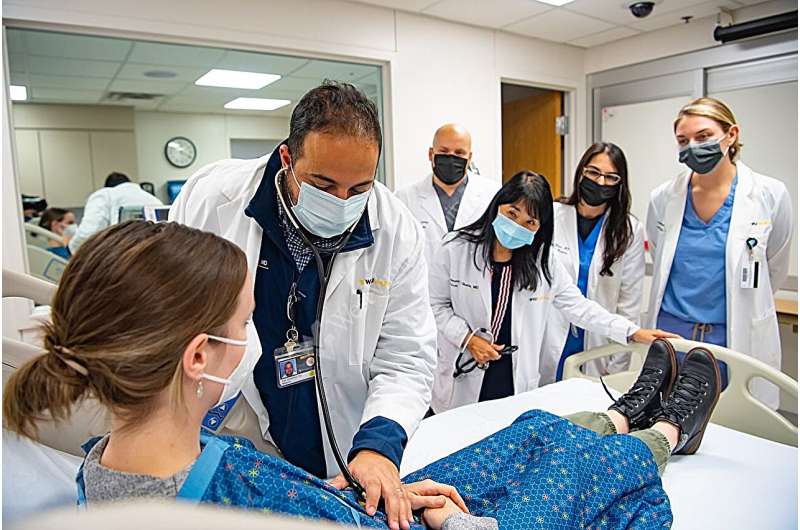This article has been reviewed according to Science X's editorial process and policies. Editors have highlighted the following attributes while ensuring the content's credibility:
fact-checked
trusted source
proofread
Standardized protocols help hospitals treat strokes faster, research finds

West Virginia University research illustrates that American Heart Association and American Stroke Association guidelines are effective at speeding up hospitals' response times for stroke treatment and can be mastered even by members of "ad hoc" medical teams that assemble rapidly on the fly.
Swift stroke treatment is critical, so when a stroke patient arrives at an emergency room, specialists from across hospital departments—EMS, neurologists, pharmacists, physicians, nurses, radiologists and technicians—rush to coordinate a team response. AHA and ASA guidelines, or "best practices," put specific limits on how much time can optimally elapse between the onset of ischemic stroke, in which blood flow to the brain is blocked, and subsequent events like arrival at the hospital and delivery of an infusion.
However, experts have questioned whether the communication of those best practices helps medical teams that assemble temporarily and whose members don't typically collaborate.
A Journal of Operations Management paper by WVU John Chambers College of Business and Economics associate professor Bernardo Quiroga and co-authors answers that question using data about more than 8,000 patients who received stroke care at a large hospital (not WVU Hospitals) between 2009 and 2017.
"'Time is brain' for stroke victims," Quiroga explained. "Blocked blood flow to the brain kills almost two million neurons a minute, so your life or ability to walk or talk hinges on how quickly multiple professionals coordinate to restore blood flow. If you're lucky, you're treated within the first hour of symptom onset. Better yet, you receive a shot of tissue plasminogen activator, which dissolves clots. TPA works better the earlier it's given and usually isn't effective after 4.5 hours."
In 2010, the AHA and ASA launched Target: Stroke, a program that identifies stroke care best practices and standardizes each step in the process. Participating hospitals reduced median treatment times from 79 minutes in 2009 to 51 minutes in 2017, but it wasn't clear if that improvement was driven by adherence to best practices or by clinicians learning through repetition as they handled more stroke cases.
To figure that out, the researchers investigated whether repeated "learning by doing" decreased the hospital's stroke care time. Then, they evaluated whether deliberate, "induced" learning and implementation of AHA/ASA best practices decreased the time further.
Learning through repetition worked. The more strokes the hospital treated, the faster it responded. For each doubling of cumulative stroke alerts, "door-to-needle time"—the time to get patients from the hospital door to a TPA infusion—decreased by 10.2%.
Best practices also worked. Specifically, the researchers examined two best practices: the Helsinki Model protocol, which directs that EMS staff keep stroke patients on the stretcher for transport to the CT room rather than transferring them to ER beds; and the rapid administration of TPA protocol, which requires the pharmacist to be in the CT room with TPA before completion of the CT scan. Those protocols significantly reduced the hospital's door-to-needle time beyond improvements from repetition-based learning.
According to Quiroga's co-author and former Ph.D. student Brandon Lee, that matters because it demonstrates the efficacy of best practices and shows ad hoc teams learning guidelines and implementing them long-term.
However, Lee emphasized the importance of the presence of the hospital's stroke advisory committee, which set targets, evaluated stroke teams' performances and gave feedback.
Without similar "countermeasures to organizational forgetting," Quiroga acknowledged that best practices aren't always sustainable, especially on ad hoc teams.
"In the case of the best practice indicated by the Helsinki Model, compliance is difficult because the hospital needs to coordinate with multiple independent EMS systems. Some EMS providers may be reluctant to commit resources to extended time in the CT room, and EMS staff turnover may lead to forgetting," Quiroga said.
Lee added, "Overall, because ad hoc teams are fluid, information sharing is harder. And when a group of people don't know each other well, group learning slows. But although ad hoc teams learn more slowly, we determined they still learn."
The research also assessed whether neurologists' abilities to meet time goals were affected by their recent experiences treating prior stroke patients.
"As team leaders, neurologists can have an outsized influence on performance," Quiroga said. "Because other members of the ad hoc team aren't familiar with each other, they lean on their leader."
But data showed stroke teams improving response times regardless of how many stroke cases the neurologist had treated individually or what the neurologist's recent success rate was. Quiroga said that's good news.
"The implication is that learning and sustaining best practices ensures an even quality of care for patients, regardless of individual neurologists' experience levels."
More information: Brandon Lee et al, An empirical analysis of process improvement from best practice adoption: A study of stroke care best practices, Journal of Operations Management (2024). DOI: 10.1002/joom.1301



















